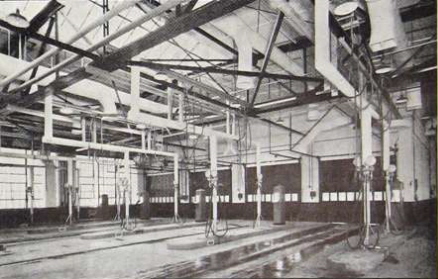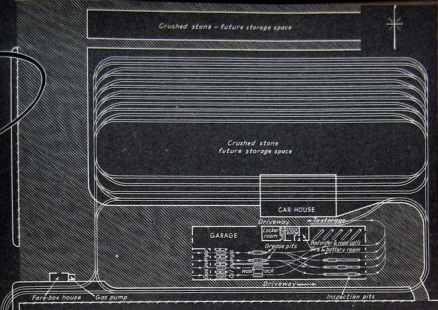| . |
| . |
| . |
| . |
| . |


| DETROIT TRANSIT HISTORY |
| DETROIT TRANSIT HISTORY |

| .. |
| For Comments and/or Suggestions, Please contact Site Owner at: admin@detroittransithistory.info |
© 2009 (PAGE LAST MODIFIED ON 01-02-10)
| THE HISTORY OF THE COOLIDGE TERMINAL |
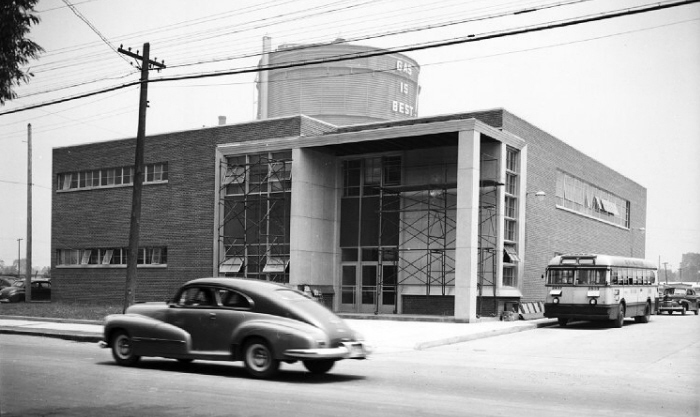
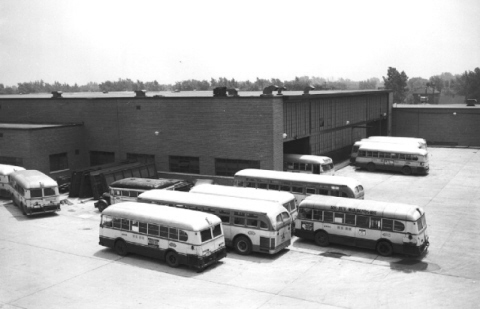
| ||||||||||||||||||||||||||||||||||||||
| Click here to return to "THE D-DOT YEARS" Main Page. |
| This Detroit News photo from June 22, 1948, shows the new $199,800 Coolidge Terminal office building nearing the final stages of construction as part of an extensive $2.6 million DSR modernization and rehabilitation project. Also visible is the "Gas is Best!" natural gas reservoir in the distant background. These huge structures were once a common sight in Detroit. (Walter P. Reuther Library, Wayne State University photo #29982 — see disclaimer below) |

The Fourteenth Street line — which was
roughly equivalent to combining today's
Linwood line with the 14th Street portion
of the Fenkell line — required miles of
deadheading to reach. Access to the line
required pulling-out along the rails of both
the Grand River and Oakman lines until
reaching the route at Ewald Circle and
Livernois. Later, when the Oakman line
was discontinued in December, 1945, and
its rails removed, access from Coolidge
was cut-off and the Fourteenth car
line was transferred to the Woodward
Carhouse in Highland Park. This again
left Grand River as the only car line
operating out of the Coolidge location.
Also located on the property was a DSR
bus operation, which had been expanding
rapidly since launched in 1925. During the
early years most bus routes were short
feeders under two miles, requiring one or
two buses. When Coolidge opened in
1928, there were seven other bus garages
in operation at the time. However, many of
the smaller leased buildings, such as the
American and Ward Avenue Garages,
were closed within a few months.
By 1937, only three of the largest garages
were left to house the DSR's fleet of 1,152
buses, of which 304 were assigned to the
Coolidge Garage (the second largest in
the system). The remainder of the fleet
was divided between the Highland Park
Garage (597 coaches) and the east-side
Kercheval Garage (251). But with the
DSR's bus operation continuing to expand,
more bus facilities were later added to
other properties. In 1938, the Coolidge
Garage underwent a major expansion
program, and bus capacity at Coolidge
increased to more than 500 — mostly
small (21-pass.) — buses.
Meanwhile, starting in June of 1930, a
new mode of public transportation had
been introduced to Detroiters — electric
powered buses. On June 14, 1930, the
Plymouth Electric line began operations
on Plymouth Road. The six trackless
trolley-buses used to service the line, all
built by Twin Coach, were housed out of
the Coolidge Garage. Although there
were extensive plans to expand this type
roughly equivalent to combining today's
Linwood line with the 14th Street portion
of the Fenkell line — required miles of
deadheading to reach. Access to the line
required pulling-out along the rails of both
the Grand River and Oakman lines until
reaching the route at Ewald Circle and
Livernois. Later, when the Oakman line
was discontinued in December, 1945, and
its rails removed, access from Coolidge
was cut-off and the Fourteenth car
line was transferred to the Woodward
Carhouse in Highland Park. This again
left Grand River as the only car line
operating out of the Coolidge location.
Also located on the property was a DSR
bus operation, which had been expanding
rapidly since launched in 1925. During the
early years most bus routes were short
feeders under two miles, requiring one or
two buses. When Coolidge opened in
1928, there were seven other bus garages
in operation at the time. However, many of
the smaller leased buildings, such as the
American and Ward Avenue Garages,
were closed within a few months.
By 1937, only three of the largest garages
were left to house the DSR's fleet of 1,152
buses, of which 304 were assigned to the
Coolidge Garage (the second largest in
the system). The remainder of the fleet
was divided between the Highland Park
Garage (597 coaches) and the east-side
Kercheval Garage (251). But with the
DSR's bus operation continuing to expand,
more bus facilities were later added to
other properties. In 1938, the Coolidge
Garage underwent a major expansion
program, and bus capacity at Coolidge
increased to more than 500 — mostly
small (21-pass.) — buses.
Meanwhile, starting in June of 1930, a
new mode of public transportation had
been introduced to Detroiters — electric
powered buses. On June 14, 1930, the
Plymouth Electric line began operations
on Plymouth Road. The six trackless
trolley-buses used to service the line, all
built by Twin Coach, were housed out of
the Coolidge Garage. Although there
were extensive plans to expand this type
When the Detroit Department of Street Railways (DSR) opened its new Coolidge Carhouse and Bus Garage
on Sunday, February 26, 1928, it would place into operation the first transit property built by the City of Detroit that
could accommodate both streetcars and buses. Originally named after Coolidge Highway — the street on which it
was located (which was renamed Schaefer Rd. in 1931) — the combined streetcar and bus facility was constructed
on the city's then sparsely populated northwest-side, within territory recently annexed from Greenfield Township.
Located nearly eight miles from downtown, Coolidge would be the farthest removed DSR facility from the city's core
street railway grid, but the closest to the developing newly acquired territories on the city's north and west sides.
On the day the Coolidge facility opened, the Grand River streetcar line (which was just split-off from the previously
combined Jefferson-Grand River line the year prior) was transferred from the east-side Jefferson Carhouse to
the new Coolidge Carhouse. Initially, Grand River was the only car line serviced by the Coolidge facility — being
easily accessible, with the carhouse located about ¼-of-a-mile north of the intersection of Grand River and Coolidge.
Although built for streetcar service, only two car lines operated out of the Coolidge facility. Because of its far-away
distance from most of the pre-1920s built street railway lines, only the heavily traveled Grand River line (which
required a large fleet of cars), and later, the lightly traveled Fourteenth Street line (which was a good distance
away via rail), were assigned to the facility.
on Sunday, February 26, 1928, it would place into operation the first transit property built by the City of Detroit that
could accommodate both streetcars and buses. Originally named after Coolidge Highway — the street on which it
was located (which was renamed Schaefer Rd. in 1931) — the combined streetcar and bus facility was constructed
on the city's then sparsely populated northwest-side, within territory recently annexed from Greenfield Township.
Located nearly eight miles from downtown, Coolidge would be the farthest removed DSR facility from the city's core
street railway grid, but the closest to the developing newly acquired territories on the city's north and west sides.
On the day the Coolidge facility opened, the Grand River streetcar line (which was just split-off from the previously
combined Jefferson-Grand River line the year prior) was transferred from the east-side Jefferson Carhouse to
the new Coolidge Carhouse. Initially, Grand River was the only car line serviced by the Coolidge facility — being
easily accessible, with the carhouse located about ¼-of-a-mile north of the intersection of Grand River and Coolidge.
Although built for streetcar service, only two car lines operated out of the Coolidge facility. Because of its far-away
distance from most of the pre-1920s built street railway lines, only the heavily traveled Grand River line (which
required a large fleet of cars), and later, the lightly traveled Fourteenth Street line (which was a good distance
away via rail), were assigned to the facility.

of service along the city's west-side, economics forced the electric trolley-bus service to be discontinued on Aug. 8,
1937. The Plymouth electric buses had unfortunately become a casualty of The Great Depression of the 1930s.
During the years leading up to the second world war, the DSR continued to expand its bus operations, including a
plan made just prior to the war to replace the streetcars on the heavy Grand River line with motor buses. However,
the arrival of World War-II resulted in government imposed regulations favoring increasing the usage of streetcars,
but the limiting of bus mileage, to help conserve rubber and gasoline for the war effort. These restrictions would
place the DSR's bus conversion plans temporarily on hold.
1937. The Plymouth electric buses had unfortunately become a casualty of The Great Depression of the 1930s.
During the years leading up to the second world war, the DSR continued to expand its bus operations, including a
plan made just prior to the war to replace the streetcars on the heavy Grand River line with motor buses. However,
the arrival of World War-II resulted in government imposed regulations favoring increasing the usage of streetcars,
but the limiting of bus mileage, to help conserve rubber and gasoline for the war effort. These restrictions would
place the DSR's bus conversion plans temporarily on hold.
However, after the end of the war, the
DSR would again focus on its prewar
campaign to convert its entire system
over to "all-buses" by the early 1950s.
New bus facilities would be needed
to accommodate the expanding
motor coach operation. In addition
to plans to construct a new all-bus
terminal immediately adjacent to the
proposed Edsel Ford Expressway,
it was also determined that a number
of current facilities would have to be
remodeled and modernized to
accommodate the growing bus fleet.
In 1947, phase one of a $6 million
terminal modernization program was
completed with the opening of new
DSR would again focus on its prewar
campaign to convert its entire system
over to "all-buses" by the early 1950s.
New bus facilities would be needed
to accommodate the expanding
motor coach operation. In addition
to plans to construct a new all-bus
terminal immediately adjacent to the
proposed Edsel Ford Expressway,
it was also determined that a number
of current facilities would have to be
remodeled and modernized to
accommodate the growing bus fleet.
In 1947, phase one of a $6 million
terminal modernization program was
completed with the opening of new
| This Xerox photo shows a fleet of DSR Peter Witt style cars parked along the north end of the Coolidge property. Prior to 1947, streetcars assigned to the Grand River and Fourteenth Street car lines operated out of the Coolidge Carhouse. (Xerox photo copy courtesy of Kenneth Schramm) |
large storage bays that were added to the east-side Shoemaker Terminal. That same year, construction would
begin on the new Samuel T. Gilbert Terminal, an all bus facility built within the city's mid-town section.
Also included in that $6 million project was an extensive $2.6 million modernization and rehabilitation program
begun at the Coolidge facility. Effective May 4, 1947, the Coolidge Carhouse was closed and the Grand River
streetcar line was converted to motor bus operation the following day. The cars and tracks on the property were
removed and the former buildings completely demolished, with new buildings of "modern design" erected. An
agreement was also reached with the Arrow Steel Company, whose premises were adjacent to the Coolidge
property, for the storage of DSR buses during the construction of a new storage garage. An amount of $800.00 was
to be paid to the company for temporary storage of coaches over a six month period. Although similar in both
design and layout to the Gilbert Terminal (also under construction at the time), the redesigned Coolidge facility
had more storage capacity and a somewhat larger floor area in its maintenance department. Both terminals were
designed by the architectural firm, Harley, Ellington & Day, Inc., and both facilities were completed in June of 1948.
The following is an estimated cost run-down for rebuilding and modernizing the Coolidge Terminal during 1947-48.
begin on the new Samuel T. Gilbert Terminal, an all bus facility built within the city's mid-town section.
Also included in that $6 million project was an extensive $2.6 million modernization and rehabilitation program
begun at the Coolidge facility. Effective May 4, 1947, the Coolidge Carhouse was closed and the Grand River
streetcar line was converted to motor bus operation the following day. The cars and tracks on the property were
removed and the former buildings completely demolished, with new buildings of "modern design" erected. An
agreement was also reached with the Arrow Steel Company, whose premises were adjacent to the Coolidge
property, for the storage of DSR buses during the construction of a new storage garage. An amount of $800.00 was
to be paid to the company for temporary storage of coaches over a six month period. Although similar in both
design and layout to the Gilbert Terminal (also under construction at the time), the redesigned Coolidge facility
had more storage capacity and a somewhat larger floor area in its maintenance department. Both terminals were
designed by the architectural firm, Harley, Ellington & Day, Inc., and both facilities were completed in June of 1948.
The following is an estimated cost run-down for rebuilding and modernizing the Coolidge Terminal during 1947-48.
In 1951 more changes were in store for the Coolidge Terminal when the Grand River bus line was converted
over to electric trackless trolley-coaches — with gradual conversion beginning in July of 1951. The property had to
be upgraded with trolley related hardware and wired to accommodate the new fleet of electric powered coaches. All
eighty of the St. Louis Car Company built electric trackless trolley-coaches used to service the Grand River line
were based out of the Coolidge Terminal.
over to electric trackless trolley-coaches — with gradual conversion beginning in July of 1951. The property had to
be upgraded with trolley related hardware and wired to accommodate the new fleet of electric powered coaches. All
eighty of the St. Louis Car Company built electric trackless trolley-coaches used to service the Grand River line
were based out of the Coolidge Terminal.
| This June 1948 photo shows the entrance area to the recently completed Coolidge Terminal Vehicle Maintenance building. Although similar in both layout-design and appearance to the DSR's recently constructed Gilbert Terminal facility, the redesigned Coolidge facility had more storage capacity and a somewhat larger floor area in its maintenance department. (Walter P. Reuther Library, Wayne State University photo #29982_1 — see below) |
(*Figures were acquired from the article titled "DSR New Bus Garages" - October, 1948 edition of "BUS TRANSPORTATION" — courtesy of Tom's Trolleybus Pix Detroit)
During their heyday, the electrics provided frequent service. A DSR Weekday "School Closed" Schedules Analysis
Report, effective June 24, 1954, shows the Grand River line required 58 trolley-coaches for the A.M. peak service,
60 for the P.M. peak, and 27 were needed for base operation. Two minute headways were scheduled for A.M. and
P.M. operation, and four minute headways for the base service. Only three coaches were needed for owl runs.
But after DSR management decided during the mid-1950s to replace the entire fleet with GM diesel buses, the
department began phasing out its electric trolley-coaches. On Nov. 16, 1962, trolley-coach service on the Grand
River line was discontinued and the Coolidge Terminal was again converted into an all motor bus facility, at the
time housing mostly GM diesel buses. The facility has remained an all bus operation to this day.
Report, effective June 24, 1954, shows the Grand River line required 58 trolley-coaches for the A.M. peak service,
60 for the P.M. peak, and 27 were needed for base operation. Two minute headways were scheduled for A.M. and
P.M. operation, and four minute headways for the base service. Only three coaches were needed for owl runs.
But after DSR management decided during the mid-1950s to replace the entire fleet with GM diesel buses, the
department began phasing out its electric trolley-coaches. On Nov. 16, 1962, trolley-coach service on the Grand
River line was discontinued and the Coolidge Terminal was again converted into an all motor bus facility, at the
time housing mostly GM diesel buses. The facility has remained an all bus operation to this day.
During those first years as an "all-bus" facility, as many as 411 coaches were required to maintain the scheduled
service on lines assigned to the Coolidge Terminal. The following table shows which bus routes were assigned to
Coolidge for the weekday "School Open" schedules which took effect on Sept. 6, 1950. The table also displays the
total number of weekday runs assigned to each line......
service on lines assigned to the Coolidge Terminal. The following table shows which bus routes were assigned to
Coolidge for the weekday "School Open" schedules which took effect on Sept. 6, 1950. The table also displays the
total number of weekday runs assigned to each line......
| Between 1951 and 1962, a fleet of 80 electric trackless trolley-coaches, assigned to the Grand River line, were based out of the Coolidge Terminal. For the most part, these rubber-tire electric buses—built by the St. Louis Car Co.—were stored out of doors along the back dock at the east end of the property, as seen in the above photo. (photo courtesy of the S. Sycko photo collection) |
| |||||||||||||||||||||||||||||||||||||||||||||||||||||||||
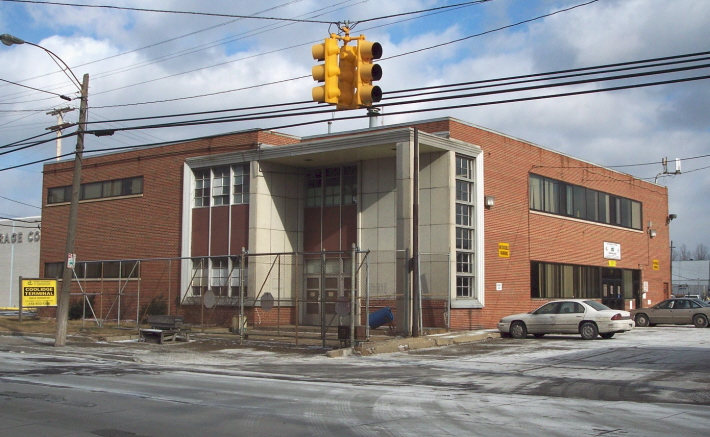
| (January 2008 photo taken by Reggie A. Craig) |
Today, the Coolidge Terminal facility continues as one of three bus terminals still owned by the Detroit
Department of Transportation (DDOT). Over the years — while operating under a three-terminal operation — the
facility serviced most of the north and west-side DDOT routes. However, with the east-side Shoemaker Terminal
currently closed as part of a massive reconstruction project, the Coolidge Terminal operates as one of two
terminals currently servicing the city. Currently, a fleet of nearly 260 coaches are assigned to the facility. The
location also houses DDOT's emergency radio dispatch and customer service communication operations.
Department of Transportation (DDOT). Over the years — while operating under a three-terminal operation — the
facility serviced most of the north and west-side DDOT routes. However, with the east-side Shoemaker Terminal
currently closed as part of a massive reconstruction project, the Coolidge Terminal operates as one of two
terminals currently servicing the city. Currently, a fleet of nearly 260 coaches are assigned to the facility. The
location also houses DDOT's emergency radio dispatch and customer service communication operations.
Virtual Motor City Collection photos #29982 and 29982_1 used by permission of the Walter P. Reuther Library, Wayne State University.
All rights, including those of further reproduction and/or publication, are reserved in full by the Walter P. Reuther Library, Wayne State University. Photographic
reproductions may be protected by U.S. copyright law (U.S. Title 17). The user is fully responsible for copyright infringement.
All rights, including those of further reproduction and/or publication, are reserved in full by the Walter P. Reuther Library, Wayne State University. Photographic
reproductions may be protected by U.S. copyright law (U.S. Title 17). The user is fully responsible for copyright infringement.
Information for the above article was compiled from various sources, including "DETROIT'S STREET RAILWAYS Vol II: City Lines 1922-1956" by Schramm,
Henning and Dworman (Bulletin 120 – Central Electric Railfans' Association); from Motor Coach Age magazine articles "Detroit's DSR, Parts 1 thru 3" written by
Jack E. Schramm; and from miscellaneous articles posted at Tom's Trolley Bus Pix – Detroit. Additional information also obtained from the 1947 edition of the
Journal of the Detroit Common Council. September 6, 1950 and June 24, 1954 DSR Schedule Analysis and Headway Reports courtesy of Tom Breeding.
Henning and Dworman (Bulletin 120 – Central Electric Railfans' Association); from Motor Coach Age magazine articles "Detroit's DSR, Parts 1 thru 3" written by
Jack E. Schramm; and from miscellaneous articles posted at Tom's Trolley Bus Pix – Detroit. Additional information also obtained from the 1947 edition of the
Journal of the Detroit Common Council. September 6, 1950 and June 24, 1954 DSR Schedule Analysis and Headway Reports courtesy of Tom Breeding.
FOR RELATED TOPICS SEE:
- FORMER D.S.R CARBARNS & BUS GARAGES
THE SAMUEL T. GILBERT TERMINAL (coming later)
THE HIGHLAND PARK TERMINAL (coming later)
THE SHOEMAKER TERMINAL
THE WYOMING TERMINAL
| The unique website which takes a detailed look back at the History of Public Transportation in and around the City of Detroit. |
| . |
ATTENTION VISITORS: Certain browsers and operating systems, particularly with Mac PCs, may distort the layout of this web-page. It is recommended this
page be viewed using recent versions of Internet Explorer and/or Windows (OS). Changing the default (medium) text size will also affect how page displays.
page be viewed using recent versions of Internet Explorer and/or Windows (OS). Changing the default (medium) text size will also affect how page displays.

